PureInsight | May 21, 2023
[PureInsight.org] As one of the four ancient civilizations in the world, China has all history of building structures similar in form and nature to the pyramids of Egypt and the Maya. According to archaeological and documentary records, China also has "pyramid" architecture.
The timeless classic "Shan Hai Jing" is not a mythical work of fiction, but a true record of ancient civilizations, cultures, and natural environments. Many of its accounts are reliable and trustworthy. In the sections such as "Wu Zang Shan Jing," "Hai Wai Si Jing," "Da Huang Si Jing," and "Hai Nei Wu Jing," it describes how Yu the Great, while controlling the flood, built several square terraced buildings called "Di Yao Tai," "Di Ku Tai," "Di Dan Zhu Tai," and "Di Shun Tai," with "two towers each, square in shape, located in the northeast of Kunlun." Scholars have pointed out that the "Terraces of the Emperors" were all double-layered overlapping structures, similar in appearance to the early Egyptian pyramids and the Mesoamerican pyramids.
The "Terraces of the Emperors" are located in Ordos, and the specific location of "northeast of Kunlun" is the southern part of the Yellow River loop in the Ordos Plateau. The "Terraces of the Emperors" that are said to be "in the northeast of Kunlun" should be located in the northern part of Jungar Banner, in the city of Ordos.
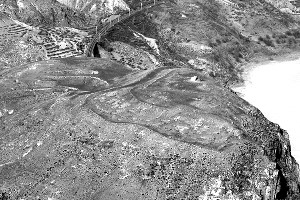
A more than 5,000-year-old ancient site, surrounded by a stone wall, has been buried underground. It is located on the bank of the Yellow River, about 1.5 kilometers northeast of Huangcaota Village in Yaogou Township, Jungar Banner, northeast of Ordos. It is called the "Zhaizi Gedan Site". The stone wall was built according to the shape of the mountain, with an irregular shape, about 160 meters in the longest north-south diameter and about 110 meters in the longest east-west diameter, slightly oval in shape, covering an area of about 15,000 square meters.
In the central area inside the wall, there is a trapezoidal high platform base, which is about 30 meters long on the bottom and built artificially. The surrounding walls were piled up using the natural slope, forming a two-level trapezoidal shape. This is a sacrificial site for religious affairs. The nature and form of the altar are the same as the pyramids of ancient Egypt and Maya culture, as well as the "Zhongdi Zhi Tai" described in the "Shan Hai Jing". The location also happens to be in the area speculated by scholars. The "Zhaizi Gedan Site" dates back to about 5,000 years ago, which is equivalent to the era of the Three Sovereigns and Five Emperors in ancient history and legends.
The Xi'an Xianyang Pyramid Group
In ancient China, imperial and noble tombs were constructed using mounds of earth piled on top of the burial chamber, creating a flat-topped hill called a "ling". This practice began in the Shang and Zhou dynasties and conforms to the definition of "pyramid" architecture. The number of these tombs is enormous, with estimates of over a hundred within a hundred-kilometer radius of Xi'an.
The existence of the Xi'an Xianyang pyramids was discovered as early as 1916 by Aurel Stein. In the 1960s, American satellites discovered a group of imperial tombs on the plains of Xianyang, which were suspected to be military strongholds. In the early 1970s, US President Nixon visited China and sent representatives to the tombs, exclaiming that this was China's pyramid group. In recent years, American satellite maps have also shown that there are as many as 16 pyramids in Xi'an, China!
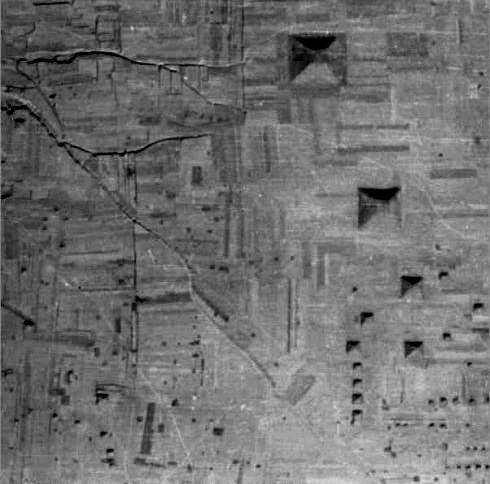
According to analysis of the satellite maps of Xi'an, the orientation and layout of the pyramids are very similar to those in Egypt. Just like pyramids around the world, there are also certain mathematical formulas between the pyramids. Since the pyramids in China and those in Egypt are on the same latitude line, the Chinese pyramids are not just 16 ordinary mountains.
The three largest pyramids are located at the northernmost end, and the rest are arranged in order from north to south, until the smallest one at the southernmost end. The total distance of the pyramid arrangement on the plain is about 10 kilometers, and there are also some small pyramid groups in the jungle. The average height of the pyramid group is about 300-400 meters, and the tallest pyramid, including the base, has a total height of about 500 meters.
The farthest date of Egypt's pyramids is only over 4600 years ago, and the highest Khufu pyramid is only 146.5 meters. The 500-meter-high Chinese pyramid tombs are unique in the world.
The four sides of the pyramid are aligned with the four cardinal directions of north, south, east, and west, symbolizing the ancient meanings of the four directions represented by the colors black for north, red for south, blue for east, and white for west. Due to the yellow soil covering the top of the pyramids, they appear to lack the direct visual concept of Egyptian pyramids.
The stairs leading to the top of the pyramid are covered with broken stones, and the edges of the base of the pyramid are still visible, made of rough stones, with each stone surface about 28 square centimeters. The method of building the pyramid is similar to that of ancient Chinese ordinary architecture, which is built by stacking stones with clay. Due to the dense forest cover and the filling of gullies with broken stones, the pyramids appear more like natural mountains.
"Xianyang Wulingyuan"

On the vast plain of Xianyang, spanning dozens of kilometers north and south and nearly a hundred kilometers east and west, nearly a thousand tombs are arranged in a straight line along the Han River canal, forming a giant formation known as the "pyramid cluster of China". Among the tombs of emperors and officials that stretch for miles, the order from east to west is: the tomb of Emperor Jing, the tomb of Emperor Gaozu, the tomb of Emperor Hui, the tomb of Emperor Ai, the tomb of Emperor Yuan, the tomb of Emperor Ping, the tomb of Emperor Cheng, the tomb of Emperor Zhao, and the tomb of Emperor Wu. Among them, the five tombs of Emperor Gaozu, Emperor Jing, Emperor Hui, Emperor Zhao, and Emperor Ping, which had cities and counties built around them, had a significant impact, so they were named "Wuling Plain".
"The Five Lingyan Mausoleums of Xianyang" are located in the northern part of Xianyang City, stretching from Xingping City in the west to Gaoling County in the east, bordering Jingyang County to the north and reaching the north bank of the Wei River to the south. It is about 40 kilometers long from east to west, about 13.5 kilometers wide from north to south, and has a total area of about 500 square kilometers. It holds an extremely important position in the tomb culture. With beautiful mountains and clear waters, it is considered a Fengshui treasure land by rulers of past dynasties, and has become a royal mausoleum area.
Chinese historians say that the name of the "Wulingyuan" in Xianyang, China has existed for a long time, and local people call the imperial tombs on the Wulingyuan "tu ge da", which means "lumps of earth".
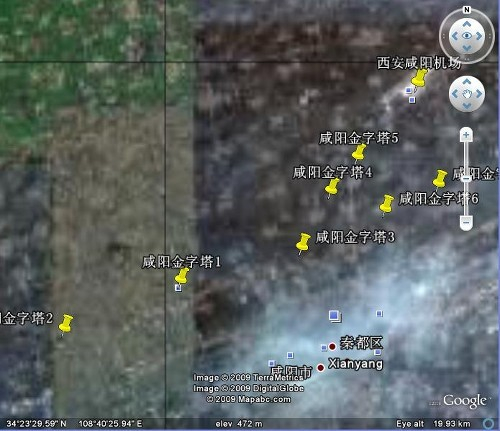
1. Maoling, Emperor Wu of Han; 2. Pingling, Emperor Zhao of Han; 3. Yanling, Emperor Cheng of Han; 4. Kangling, Emperor Ping of Han; 5. Zhouling, King Wu of Zhou; 6. Weiling, Emperor Yuan of Han; 7. Yiling, Emperor Ai of Han
A White Pyramid Discovered in "Death Valley" on China-India Border
During World War II, American Air Force pilots frequently flew over the Himalayas at the China-India border to transport food and military supplies to the Chinese army. In 1945, during one of these flights across the "Death Valley," pilot James Gaussman suddenly found that one of the two engines of his plane had malfunctioned and was about to fail. As the fuel in the plane began to freeze, Gaussman made the risky decision to fly at low altitude. When the plane's condition improved, a strange phenomenon occurred. As it was heading back to base, the plane suddenly lost control and flew in a "Z" shape, desperately avoiding the mountains in the "Death Valley" airspace.
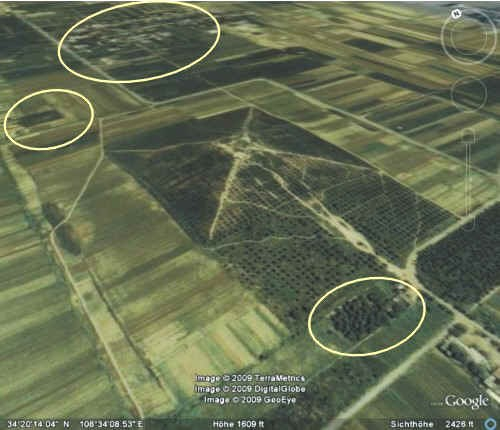
When he looked down under the belly of the plane, he suddenly saw a huge silver-white pyramid. It seemed to be made of a white luminescent material, possibly a metallic material or a strange stone. There was also a huge crystal-like object shining like a gemstone on top of the pyramid. He was suddenly stunned by this miraculous giant object.
Before flying back, Gaussman circled the silver-white pyramid three times. He firmly believed that if the giant shining object he discovered was indeed a pyramid, it would shock the world.
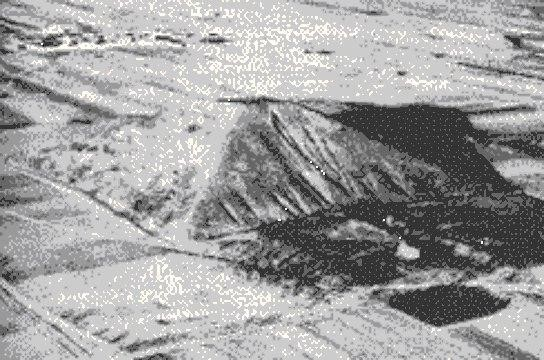
The New York Sunday Times reported on March 30, 1947 and published the first frame photo of the white pyramid, which was taken by Gaussman after landing. However, at that time, it was shortly after the war, and the report was soon forgotten by the world.
Later, explorers came to China and surveyed the area, confirming that the white giant pyramid was located 40 miles southwest of Xi'an, and was actually Emperor Wu of Han's Maoling tomb. It is the largest pyramid in the world, approximately 300 meters tall, with a total height of about 500 meters including the base.
The Maoling Mausoleum is the "Great White Pyramid"
The amazing "Great White Pyramid" was first discovered in 1912, when two American travel agencies claimed to have found a huge pyramid in Shaanxi. According to their descriptions, the pyramid was about 300 meters high and 450 meters wide at the base, with its four corners pointing towards the four directions of the compass like a compass needle.
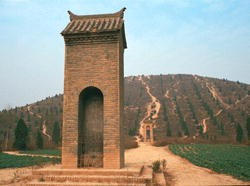
In 1978, a New Zealand researcher named Bruce L. Cathie contacted the Chinese embassy and the United States Air Force multiple times to unravel the mystery of the Chinese pyramids. He published a book on the topic in 1983.
The book mentioned, "The base of the pyramid is about 450 meters wide, and the height is about 300 meters. The exterior is stepped and square, with a square platform at the top, just like most pyramids in Egypt or Mexico." According to the book, the pyramid should be located near the Wei River downstream of Xi'an today, in the area around 34.26 degrees north latitude and 108.52 degrees east longitude.
If the pyramid is so huge and there are so many records about it, why did Western scholars overlook it?
It is speculated that one reason why Western scholars have overlooked the pyramid is that early technology was not advanced enough, and the Western world generally did not believe that China could have pyramids. It was not until 2001 that the UK had preliminary confirmation.
According to a researcher from the Xi'an Cultural Heritage Protection and Restoration Center, "Those buildings have existed for two or three thousand years, and everyone knows about them, but they just didn't associate them with pyramids."
By searching the coordinates provided by Cathie's book on Google Earth, no trace of the Great White Pyramid was found. However, two larger tower-like structures were found near the northeast of Xianyang (34.22N, 108.41E). Through analysis of Google imagery, one of the towers had a top that matched Cathie's description of "four-sided with a terrace-like top." However, this pyramid was not white and not as massive as described in the book, with a base of about 240 meters and a height of only about 40 meters.
According to an article published on the website of the British Seismological Society in 2001, and information on Wikipedia, the most likely candidate for the white pyramid-like structure is the "Mausoleum of the Emperor Wu of Han" located at approximately 34.20 degrees north latitude and 108.34 degrees east longitude. As for the differences in size and color, it could be due to misjudgment or errors caused by shadows cast by the sun.
It can now be almost confirmed that the "White Pyramid" referred to by foreigners is actually the tomb of ancient emperors. Later, more than ten giant circular relics were accidentally discovered in the southern part of the tomb area during aerial photography, adding another legend of "China's crop circles" to this already mysterious tomb.
The Disguised Uyghur Pyramids
On February 14, 2008, the Turkish newspaper Ergine Qun published an article titled "Uyghur Pyramids in Xi'an." The article claimed the discovery of pyramids in the Uyghur region with a history of 6,500 years, built by the ancient Turkic people of the Uyghur ethnic group, which predate the Egyptian pyramids by more than 100 years. The article also claimed that these pyramids were taller and more magnificent than the pyramids in Egypt and contained proto-Turkic script.
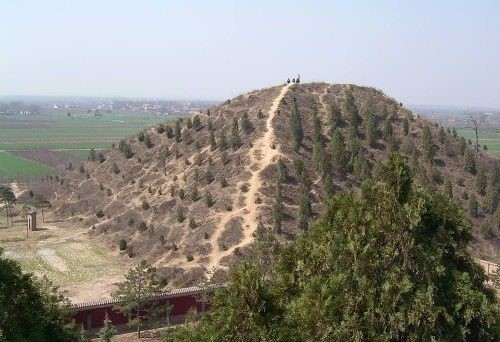
Turkish media distorted the five mausoleums of Han Dynasty in Xianyang into Turkish ancestors' pyramids, causing Turkish people to enthusiastically discuss the "Turkish Pyramids" (Turk Piramitleri). A Google search for "Turk Piramitleri" yields more than 33.8 million results, indicating that the idea of Turkish pyramids has become a consensus among Turkish people.
To be continued.
Chinese version: https://big5.zhengjian.org/node/75981
